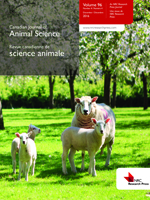McAllister, T. A., Beauchemin, K. A., Alazzeh, A. Y., Baah, J., Teather, R. M. and Stanford, K. 2011. Review: The use of direct fed microbials to mitigate pathogens and enhance production in cattle. Can. J. Anim. Sci. 91: 193-211. Direct-fed microbials (DFM) have been employed in ruminant production for over 30 yr. Originally, DFM were used primarily in young ruminants to accelerate establishment of the intestinal microflora involved in feed digestion and to promote gut health. Further advancements led to more sophisticated mixtures of DFM that are targeted at improving fiber digestion and preventing ruminal acidosis in mature cattle. Through these outcomes on fiber digestion/rumen health, second-generation DFM have also resulted in improvements in milk yield, growth and feed efficiency of cattle, but results have been inconsistent. More recently, there has been an emphasis on the development of DFM that exhibit activity in cattle against potentially zoonotic pathogens such as Escherichia coli O157:H7, Salmonella spp. and Staphylococcus aureus. Regulatory requirements have limited the microbial species within DFM products to organisms that are generally recognized as safe, such as lactic acid-producing bacteria (e.g., Lactobacillus and Enterococcus spp.), fungi (e.g., Aspergillus oryzae), or yeast (e.g., Saccharomyces cerevisiae). Direct-fed microbials of rumen origin, involving lactate-utilizing species (e.g., Megasphaera elsdenii, Selenomonas ruminantium, Propionibacterium spp.) and plant cell wall-degrading isolates of Butyrivibrio fibrisolvens have also been explored, but have not been commercially used. Development of DFM that are efficacious over a wide range of ruminant production systems remains challenging because[0] comprehensive knowledge of microbial ecology is lacking. Few studies have employed molecular techniques to study in detail the interaction of DFM with native microbial communities or the ruminant host. Advancements in the metagenomics of microbial communities and the genomics of microbial-host interactions may enable DFM to be formulated to improve production and promote health, responses that are presently often achieved through the use of antimicrobials in cattle.
How to translate text using browser tools
1 June 2011
Review: The use of direct fed microbials to mitigate pathogens and enhance production in cattle
T. A. McAllister,
K. A. Beauchemin,
A. Y. Alazzeh,
J. Baah,
R. M. Teather,
K. Stanford
ACCESS THE FULL ARTICLE
It is not available for individual sale.
This article is only available to subscribers.
It is not available for individual sale.
It is not available for individual sale.

Canadian Journal of Animal Science
Vol. 91 • No. 2
June 2011
Vol. 91 • No. 2
June 2011
acidose
Acidosis
Administration directe d'agents microbiens
bactériocines
bacteriocins
bovins
cattle




